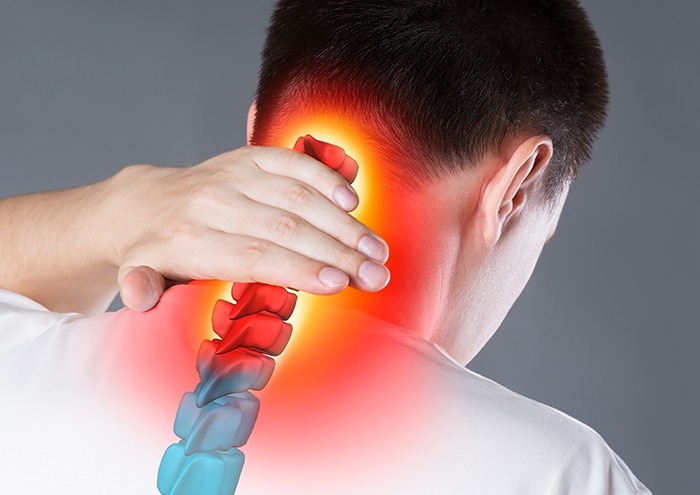
Tech neck, text neck, or its clinical term cervical kyphosis, is what happens as a result of us looking at screens all day. Whether it’s your phone screen or computer screen, odds are you’re bending over and slouching to look at it. Over time this causes an insane amount of stress on your neck and supporting musculature. More on that in a second.
You may not think you spend that much time on your devices. Others of you are fully aware that you do. Research has shown that, on average, we spend around four hours a day looking at our phones.
Add that up, and you’re looking at 1,400 hours a year! What’s more, if you have a desk job (or are working from home as more of us are these days), you’re likely staring at your computer screen for eight hours a day, if not longer, with a desk setup that’s probably not ergonomically correct. The very fact you’re reading this indicates you likely suffer from tech neck.
Here’s why this matters so much. The average human head weighs about 10-12 pounds, and as we all know from basic anatomy class, it’s held up by our neck. But here’s where things get a little more complicated.
Getting into specifics, the cervical spine (aka your neck) is made up of small vertebrae, muscles, tendons, and ligaments that allow you to move your head in the different directions that it can.
Going back to our basic anatomy class for a second, you may remember that our spine has a natural S curve to it – but we often only consider the curve at the bottom of the spine around our lumbar area while forgetting the thoracic (mid-back) and cervical spine (neck) that curve outward and inward respectively to complete the S bend. Tech neck is the straightening of the healthy curvature of the neck.
When we tilt our head forward to look down at a screen, we place exponentially more force over our cervical spine, so what is usually a 10-pound head when straight upright with proper posture becomes 27 pounds of force at just 15 degrees of head tilt. At 60 degrees of head tilt—basically looking straight down—your head is applying 60 pounds of force to the cervical spine!
Do this for a prolonged period, and bad things happen. Muscle imbalances will lead to chronic neck pain, shoulder pain, and back pain often accompanied by headaches.
As things get more extreme, you can start to feel localized aggravated pain, stiffness, reduced mobility, jaw pain due to misalignment of the cervical spine, and even numbness in the extremities due to spinal irritation and inflammation.
As if this wasn’t bad enough, the implications of tech neck continue even after you’re finished looking at your screen. The pain, soreness, or stiffness you experience can continue and make it difficult to enjoy other things you like to do.
Think about it: turning your head is important for practically every aspect of life, whether it’s enjoying fun activities, or simply reaching for a jar on a high shelf in your kitchen. An aching neck and painful shoulders are annoying at best. It’s downright dangerous at worst. Left unattended, tech neck can lead to nerve compression and disc deterioration that will likely spur a long list of chronic symptoms affecting your quality of life.
WHAT YOU CAN DO ABOUT IT
Fortunately, tech neck is easily curable but it will require some adjustments on your part. First, let’s deal with the pain. The easiest thing to do to ease the pain is simply rest. The neck, shoulder, and back muscles are straining for hours on end as we look at our screens. Step away from the screens for a minute and just rest.
Curing tech neck requires a multi-pronged approach because alleviating the pain is one thing, but we need to keep it away. Proper posture is the name of the game here, which means standing straight, squeezing your shoulder blades back, so you’re not hunching over.
If you’re so inclined, incorporate this as part of an exercise and stretching program that strengthens the neck and shoulder muscles to counteract tech neck. Other exercises include head tilts, chest openings, and “the Egyptian,” wherein you push and pull your chin back and forth.
Next involves adjusting your workspace. It’s true that looking at your phone is a contributor to tech neck, but so is the average American’s work environment. There you are, sitting at your desk, with a generic office chair and a monitor that’s probably set too low.
The human body wasn’t meant to stay seated for long periods, and standing desks puts your body in a natural position, which is better for your joints.
However, if you insist on sitting at the workspace, invest in an ergonomic chair with proper lumbar support and a headrest to support the cervical spine. Fortunately, more and more employers are providing their employees with ergonomic chairs, so it wouldn’t hurt to ask your boss. When you prop the back of your head against the headrest it’s practically impossible to tilt your head down.
No matter if you’re standing or sitting, make sure to place your monitor at eye level so you don’t have to tilt your head down to look at it. Standing desks typically have platforms that place monitors at eye level, but you can use books to raise your screen higher, regardless of what desk you’re using.
Lastly, just get up and move around. If you have a desk job then set reminders every hour to get up, walk around, and stretch. It doesn’t have to be for very long; the goal is to get some blood moving and give your muscles and joints – especially your neck – a bit of a break. -articlecity